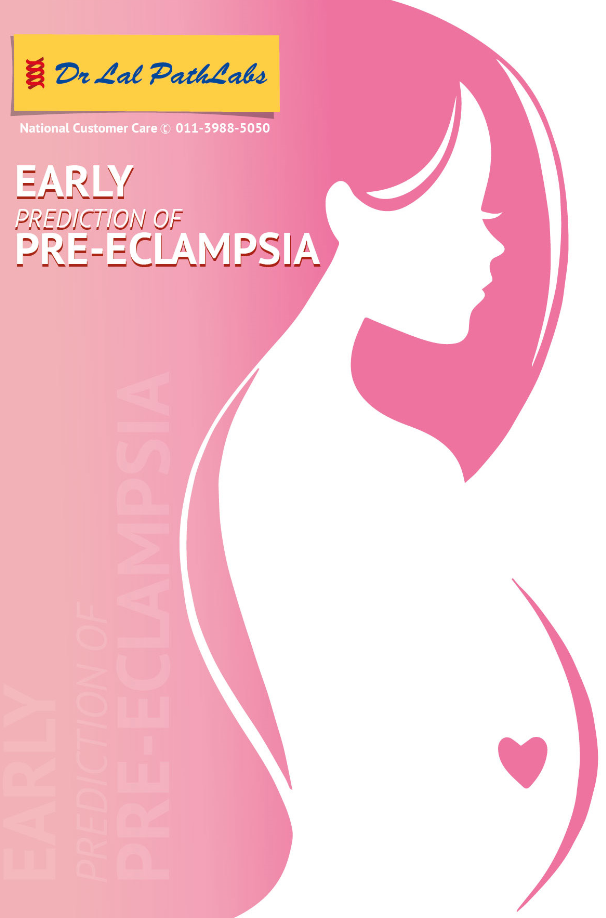Early Prediction of PRE- ECLAMPSIA

PREDICTION OF PRE-ECLAMPSIA
Pre-eclampsia (PE) is a major cause of maternal and fetal or neonatal mortality and morbidity. The disorder Complicates 5%-7% of all pregnancies 10 Each year, an estimated 50,000 women die from PE worldwide PI. If Pre-eclampsia is not diagnosed and closely monitored, it can be potentially life-threatening.
Complications
A diagnosis of PE based on blood pressure and proteinuria has positive predictive value of approximately 30% for predicting PE related adverse outcomes. Current Practices does not differentiate PE from other hypertensive pregnancy disorders in women with suspected PE.
To optimize this, reliable prediction of PE would be helpful allowing closer prenatal monitoring, timely diagnosis and timely intervention.
PRE-ECLAMPSIA PREDICTOR PANEL
Markers covered: *PLGF* sFLT*sFLT-1: PLGF RATIO
Clinical Significance:
• sFlt-1/PIGF ratio is intended to be used with clinical judgement and other investigations to diagnose Pre-eclampsia in suspected cases
Validity of the test: It may be used for testing pregnant women from 20 weeks gestation up until the time of delivery.
Sensitivity and Specificity of the test:
| Predictive Value | Sensitivity/Specificity | |
| Lower than 38 L | Negative Value: 99.3% | 80%/78.3% |
| Greater than 38 L | Positive value: 36.7% | 66.2%/83.1% |
PROGNOSIS study concluded that sFlt-1: PlGF ratio of 38 or lower can be used to predict the short-term absence of preectampsia in women in whom the syndrome is suspected clinically.
TAT: Sample by Tue /Thu / Sat 9 am: Report Same Day
PLACENTAL GROWTH FACTOR (PLGF)
Marker Covered: Placental Growth Factor (PLGF)
Clinical Significance:
• Serum levels of PIGF (placental growth factor) are altered in women with PE and can discriminate normal pregnancy from PE even before clinical symptoms occur.
• In normal pregnancy, the pro-angiogenic factor PIGF increases during the first two trimesters and then decreases as pregnancy progresses to term.
• In PE. PIGF levels have been found to be lower than in normal pregnancy test.
Validity of the test: It may be used for testing pregnant women from 10 weeks gestation up until the time of delivery.
Sensitivity and Specificity of the test:
With 82.2 % specificity and 95.7 % negative predictive value, PIGF levels tower than 62.5 pg/ml increase the risk of developing pre-eclampsia and discriminating pre-clamptic and non-pre-clampsia patients[3,4].
PRE-ECLAMPSIA SCREENING PANEL
Markers covered: Placental Growth Factor (PLGF) *Pregnancy Associated Plasma Protein A (PAPP-A)
Clinical Significance:
• For Early & late onset Pre-eclampsia Risk Assessment
• Pre-eclampsia (PE) risk assessment is done by using an algorithm that combines maternal demographic factors, mean arterial pressure, uterine-artery pulsatility index, maternal serum Pregnancy-associated plasma protein A (PAPP-A) & Placental growth factor (PIGF).
Validity of the test: Valid between 10-13 weeks gestation.
Estimated detection Rate:
Combining maternal factors with biochemical and biophysical markers is 96% for early onset PE & 77% for late onset PE at false positivity rate of 10%.
MATERNAL & PRE-ECLAMPSIA SCREENING PANEL, FIRST TRIMESTER
Markers covered: Free Beta HCG , Serum* Pregnancy Associated Plasma Protein A (PAPP-A),Serum” Placental Growth Factor (PIGF).
Clinical Significance:
• The assay is used for risk assessment of early & late onset Pre-eclampsia (PE) and prenatal screening of chromosomal anomalies (Trisomy 21.18/13).
Estimated Detection Rate:
• For Down syndrome the approximate detection rate is 85-90% with a false positive rate of 5%.
• The test has detection rate of 96% for early onset PE & 77% for late onset PE at false positivity rate of 10%.
References:
1. World Health Organization. The World Health Report 2005: make every mother and child count. November 1, 2014 (http://www.who.int/whr/2005/en/)
2. Goldenberg RL, Culhane JF, lams JD, Romero R. Epidemiology and causes of preterm birth. Lancet 2008; 371: 75-84
3. PIGF in Suspected Pre- Eclampsia: A Budget Impact Analysis PLOS ONE | DOI:10.1371/journal.pone.0164276
4. Placement Growth Factor: As an Early Second Trimester Predictive Marker for Pre-eclampsia in Normal and High-Risk Pregnancies in a Turkish Population. The Journal of Obstetrics and Gynecology of India (May-June2013) 63(3):158-163.













